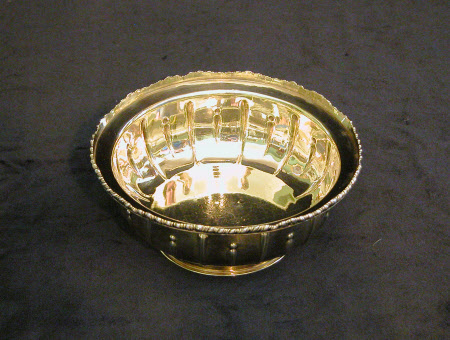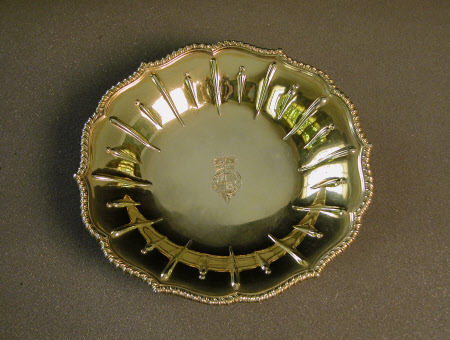Four covered sugar dishes and stands and four sugar ladles
Frederick Kandler (d.1778)
Category
Silver
Date
c. 1756 - 1759
Materials
Silver-gilt
Measurements
11.7 cm (h) x 22.2 cm (diam.). Ladles: 17.5 cm (l)
Place of origin
London
Order this imageCollection
Ickworth, Suffolk
NT 852065
Summary
Four covered sugar dishes and stands, sterling silver, gilt, by Frederick Kandler, London, 1758/9, and four associated sugar ladles, silver-gilt, by Andrea Boucheron, Turin, circa 1756. Dishes and stands: The stands are raised in the form of deep, splayed bowls on seamed, plain foot rings. Their sides are chased with twelve ribs and twelve intermediary tear-drop ribs with additional single drops above. The shaped rims have applied gadroon and moulding borders which are cast. The dishes are circular and raised as steep-sided bowls with the same ribbing as the stands, a horizontal rim and applied, cast gadroon borders. The concave foot rings are raised and seamed. The ogee-domed covers are also raised and have ribbing to conform to the dishes and stands. Their handles are in the form of three convolvulus flowers with stalks and leaves beneath. Ladles: The ladles are cast, chased and pierced with reeded stems, C-scroll and rocaille cartouches on both sides of the terminals and bowls modelled as shells on the exterior and pierced in diverging lines of droplets. Heraldry: The centre of each of the stands and the cover of each dish, adjoining the handle, is engraved with the quartered arms of the Hanoverian monarchs (pre-1801) within the Garter and beneath an imperial crown. The terminal cartouches on the undersides of the ladles are each engraved with the Hervey crest beneath an earl’s coronet. The style of engraving on the ladles is Italian (see NT 852078). Hallmarks: Stands: Marked on their undersides. No. 1 has the date letter ‘C’ and part of another mark, illegible. Nos. 2 & 3 have the date letter ‘C’, lion passant, leopard’s head and maker’s mark (partial on No. 3) ‘FK’ in italics beneath a fleur-de-lis (Arthur Grimwade, London Goldsmiths 1697-1837, 1990, no. 692) for Frederick Kandler. No. 4 has the date letter ‘C’, lion passant and part of Kandler’s mark. Dishes: All are fully marked on the underside of the rim with maker’s mark (as above), lion passant, leopard’s head and date letter ‘C’. Covers: All are marked on their undersides with maker’s mark (as above) and lion passant. Ladles: All four are marked on the underside of the stem with the maker’s mark of Andrea Boucheron (1693–1760), ‘VA’ in monogram beneath a crown (Gianfranco Fina & Luca Mana, Argenti Sabauda del XVIII Secolo, 2012, p. 222, fig. 8). Scratchweights: Stands: ‘No ۸ 1 [/]18۸2’; ‘No ۸2 [/]17۸19’; ‘No ۸3 [/]18۸8’; ‘No ۸4 [/]18۸3’ Dishes (with covers): ‘No ۸1 [/]15۸4’; ‘No ۸2 [/]14 18’; ‘No ۸3 [/]14 [sic] 15۸2’; ‘No ۸4 [/]14 [sic] 14۸2’ Ladles: ‘1 [/] 2:5’; ‘2 [/] 2:5’; ‘3 [/] 2:9’; ‘4 [/] 2:4’
Full description
DISHES & STANDS In the first half of the eighteenth century sugar was dispensed at meals from casters, such as the larger of those at Ickworth originally supplied with the Earl of Scarsdale’s epergne in 1724 (NT 852084). This continued to be the standard practice in the 1750s and Lord Bristol’s allocation of sugar dishes for use with dessert, rather than as part of the tea equipage, is one of the first recorded instances. It is likely that he was reacting to Continental custom and perhaps particularly that in Italy as the French were not such devotees of sugar as were the English and Italians.[1] A large number of zuccheriere of Turin manufacture survive from the period – probably more than any other category of plate – and many are ribbed or fluted and have floral finials for handles as do the covers of the Ickworth dishes.[2] It may be telling that although dishes for sugar did begin to appear more regularly in subsequent years in Britain, the next significant occurrence amongst ambassadorial plate was that of Sir James Gray, 2nd Bt, in 1767, and he had been stationed in Italy for much of the previous two decades.[3] Sir James, who was also destined for Spain, did not have stands, as did Lord Bristol, and nor did any of the other recipients of sugar dishes through the Jewel Office or from Wickes and Netherton or Parker and Wakelin. Many of the dishes were in fact in glass with silver mounts, as those supplied to the 4th Earl of Holderness in 1759 by Wickes and Netherton: ‘2 Cut Glass Bowls & Covers’ at £2 16s, ‘2 silver mountings’ weighing 12oz 18dwt at £6 14s and ‘2 Fine Sugar Spoons’ at £5 1s 6d.[4] Thomas Robinson, 2nd Lord Grantham must have had an especially sweet tooth as he received eight silver gilt rims for basins on going to Spain as ambassador in 1771.[5] LADLES With ever-increasing quantities of sugar being consumed as the eighteenth century progressed, casters were no longer adequate to service dessert, and multiple basins began to be provided instead (see above). As Lord Bristol’s surviving basins were not supplied until 1758 these sifters must initially have been used with some old pieces of silver improvised for the purpose, or perhaps with ceramic or glass vessels. Sugar pots are listed amongst his Dresden dessert porcelain in 1765.[6] Of all Lord Bristol’s Turin commissions these are the most obviously Italian, not needing to copy or ape London styles as the Earl would never have had such objects before, nor have been particularly familiar with them. The rococo of their terminal cartouches is typical of the forms then being produced in the city. The engraved crests do not, however, do justice to the fine quality of the ladles, being very badly executed and appearing more like indifferent dogs than majestic cats. James Rothwell, Decorative Arts Curator April 2021 [Adapted from James Rothwell, Silver for Entertaining: The Ickworth Collection, London 2017, cat. 59 & 75, pp. 145 & 163.] Notes: [1] Susan Pinkard, A Revolution in Taste: The Rise of French Cuisine, New York 2009, p. 149. [2] Gianfranco Fina & Luca Mana, Argenti Sabauda del XVIII Secolo, Milan 2012, pp. 177-203. [3] He received ‘four Sucriers wth. Covers and Spoons’ weighing 85oz 10dwt on being appointed ambassador to Spain. See The National Archives, LC 9/45, Jewel Office Delivery Book 1732–93, f. 238. [4] National Art Library, Garrard Ledgers, VAM 6 1756–60, f. 201. [5]Jewel Office Delivery Book 1732–93, op. cit. (see note 3) f. 264. [6] Patricia Ferguson, ‘Digby, Tollemache and Hervey: three aristocrats and their ceramics’, English Ceramic Circle Transactions, vol. 22 (2011), p. 84.
Provenance
Basins and stands: Jewel Office; allocated to George Hervey, 2nd Earl of Bristol (1721-75) as Ambassador to Madrid 1758; discharged to Lord Bristol 9 April 1759; by descent to the 4th Marquess of Bristol (1863-1951); accepted by the Treasury in lieu of death duties in 1956 and transferred to the National Trust. Ladles: George Hervey, 2nd Earl of Bristol (1721-75); by descent to the 4th Marquess of Bristol (1863-1951); accepted by the Treasury in lieu of death duties in 1956 and transferred to the National Trust.
Credit line
Ickworth, the Bristol Collection (National Trust)
Makers and roles
Frederick Kandler (d.1778), goldsmith Andrea Boucheron (c.1692 - 1761), goldsmith






























